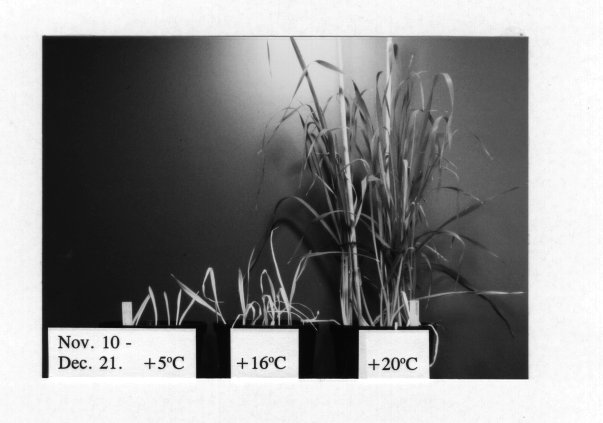
Hannu Ahokas
Division of Genetics, P. O. Box 56, FIN-00014 University of Helsinki, and
Plant Breeding Section, ARC, FIN-31600 Jokioinen, Finland.
A derivative of the pedigree 78-383/4*Adorra carried msm1 cytoplasm and was heterozygous for the restorer gene of fertility, Rfm1a, in an Adorra-like nuclear back-ground. These genetic variants have been discussed with in many earlier papers (e.g. Ahokas 1978, 1982a, 1982b). In greenhouse, the author observed an F1 plant of 78-383/4*Adorra, with longitudinal, slightly paler stripes on the green organs of shoots. With advancing spring and more solar radiation in the greenhouse, the stripes practically disappeared. A spike, fully fertile, was backcrossed with cv. Adorra. The F1 seeds were planted in the field in the 1980 season, scored and marked during the seedling stage and later. It segregated 11 fertile and 8 male sterile plants fitting to 1 : 1 (X2 = .474, P > .30). Hence, the seed parent had been msm1 and heterozygous for Rfm1a. Among the fertile plants, there were 5 normal green and 5 striped plants and 1 weak and pale all-mutant plant. Among the sterile plants, there were 3 normal green and 4 striped plants and 1 weak and pale all-mutant plant. The sectors of the mutant were evidently inherited as in those of SCS1 and SCS2 (segregating cytoplasmic streaks) of barley described earlier (Ahokas 1976). By 1986, a constant derivative homozygous for the restorer gene of fertility was developed from the pale all-mutant segregant of 78-383/5*Adorra at the F4 generation, and was called hereafter msm1-SCS. The cross of normal cv. Adorra as seed parent with msm1-SCS gave 8 all-green plants when grown side by side with the paler mutants in 1986.
The degree of paleness of mutants or mutated sectors varied from season to season. There were seasons when none of the pale all-mutant plants were able to survive under field conditions in SE Finland. Because during the relatively warm 1986 season the msm1-SCS plants grew well, the response of the all-mutant plants was assumed mainly to be caused by the growing temperature.
Grains of msm1-SCS were initiated to germinate uniformly during an overnight incubation on water agar Petri dishes and transferred into soil pots. The soil pots were kept in three different day/night temperature-conditioned rooms, set either to +20/16oC, +16/12oC, or +5/5oC. Supplementary light was provided by fluorescent tubes or by sodium vapour lamps. Also under the chilled (+5oC) conditions, the seedlings slowly reached the two-leaf stage apparently until germination had exhausted the grains' reservoirs. The chilled (+5oC) seedlings were white, but retained their turgidity at the two-leaf stage during the experiment lasting 82 days, after which they could not be recovered after transferring to 20oC. Normal barley remained green and grew slowly at +5oC. At 16oC, the seedling had white, whitish and green tissue sectors. The progress was stunted, but the plants could be made to survive easily at 20oC after 82 days. The seedling at 20oC grew normally, and produced normal, or slightly smaller spikes than the control cv. Adorra. This experiment confirmed the field observations, indicating, that the mutant is temperature-sensitive (Figure 1).

Figure 1. Plants of the msm1-SCS double mutant grown at
three different temperatures (+5, +16, or +20oC) for 41 days
showing albino response to chilled temperature.
The reciprocal crosses with cv. Adorra were repeated under greenhouse conditions.
The F1 plants with msm1-SCS as the pollen parent were
normal. Their F2 descendents were uniformly normal green also
when grown in a chilled room. The F1 plants with msm1-SCS
as the seed parent gave all-pale plants when grown under chilled conditions.
A small sample of F2 of the cross with msm1-SCS as the
seed parent was grown to maturity. Their 12 : 6 F2 segregation
of fertile : sterile fits 3 : 1 (X2 = .667, P > .30). Hence,
also the pigment deficiency is inherited with the cytoplasm in msm1-SCS.
Earlier, Kleinhofs & Warner (1974) found five cytoplasmic pigment mutants
to be temperature-sensitive.
A putative use for this conditional lethal albino is described in another paper (Ahokas 1997).
References:
Ahokas, H. 1976: Two segregating cytoplasmic mutants of barley. - Hereditas 82: 187-192.
Ahokas, H. 1978: Cytoplasmic male sterility in barley. II. Physiology and anther cytology of msm1. - Hereditas 89: 7-21.
Ahokas, H. 1982a: Cytoplasmic male sterility in barley. XI. The msm2 cytoplasm. - Genetics 102: 285-295.
Ahokas, H. 1982b: Cytoplasmic male sterility in barley. (14.) Evidence for the involvement of cytokinins in fertility restoration. - Proc. Natl. Acad. Sci. USA 79: 7605-7608.
Ahokas, H. 1997: Complementation of conditional lethals, albinos or chlorotics, or of shrunken endosperm or dwarf mutants as selectable markers in transgenic progenies of barley and other plant species. - Barley Genet. Newslett. 26 (submitted).
Kleinhofs, A. & Warner, R. L. 1974: Temperature-sensitive mutants in Hordeum vulgare L. - Crop Sci. 14: 268-271.